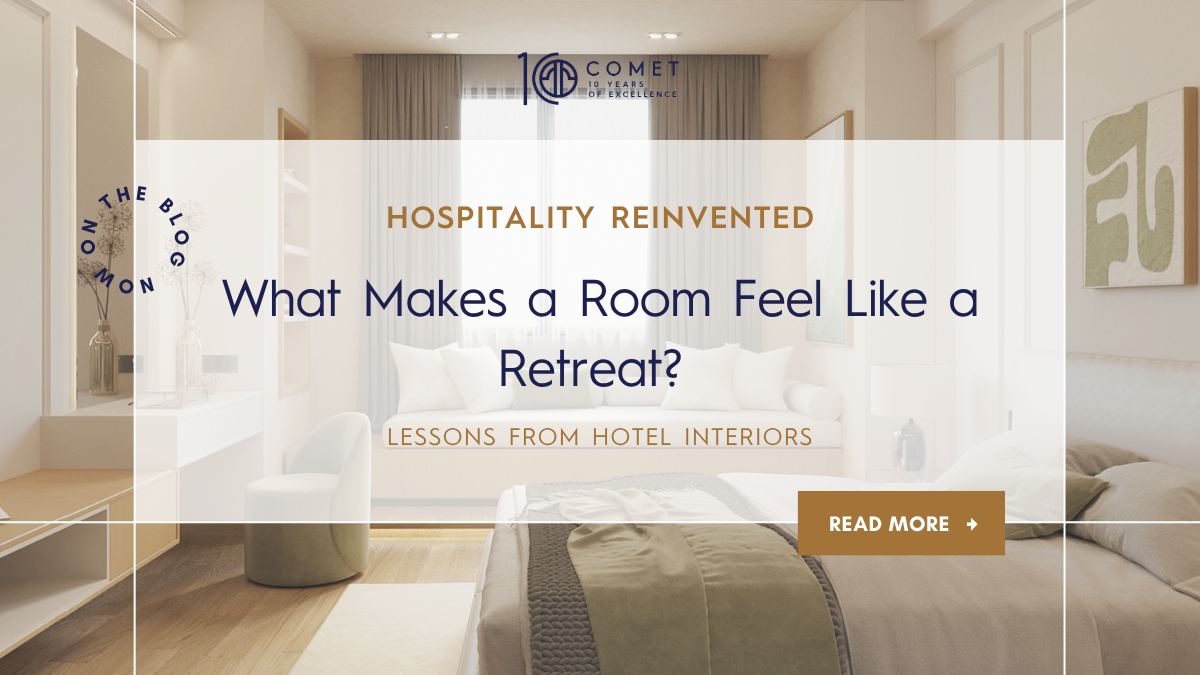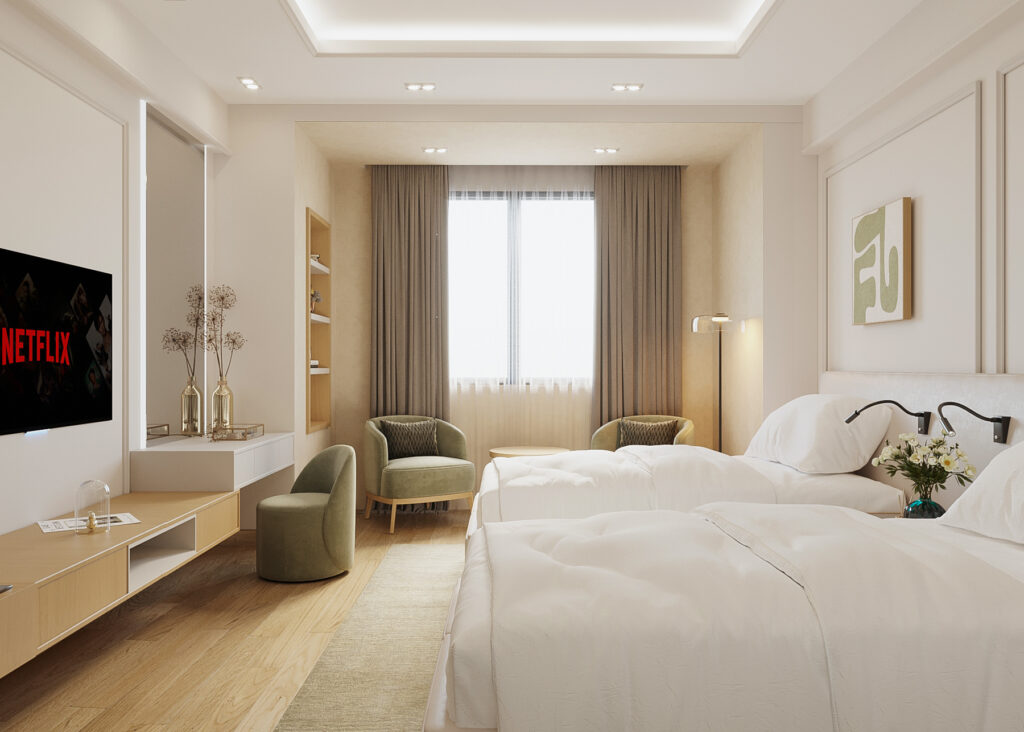
What Makes a Room Feel Like a Retreat? 9 Lessons from Hotel Interiors
In the world of hospitality design, not all hotel rooms are created equal. Some are simply places to sleep. Others — the ones you remember — invite you to rest, slow down, and breathe. They don’t just house you for the night; they restore you.
At Comet, we’ve worked on hotel interiors that do just that — including our recent work at Sonesta Hotel — blending aesthetics with subtle emotional cues to create spaces that feel like personal sanctuaries. But what exactly transforms a room from functional to restorative? And how can those same design principles be applied beyond hotels — to guest rooms, wellness spaces, even residential projects?
Let’s unpack the answer.
1. It Starts with Intentional Design, Not Decoration

A retreat-like space doesn’t come from adding more stuff — it comes from designing with intention. In hospitality interiors, every detail serves a purpose:
- Calm the senses
- Eliminate friction
- Encourage stillness and ease
That means stripping out clutter, choosing materials with care, and planning a layout that feels intuitive and unrushed. The best rooms are not crowded or chaotic — they flow, breathe, and invite.
Key takeaway: Comfort starts with clarity — not excess.
2. The Power of a Calm Color Palette
Color is emotional. That’s why the most retreat-like hotel rooms rarely rely on harsh contrasts or overly bright tones. Instead, they use a calm, cohesive palette grounded in soft neutrals:
- Warm whites, beige, taupe
- Muted earth tones
- Gentle blues and greys
At Sonesta Hotel, we chose materials and finishes in layered tones that reflect light softly and support rest. These hues reduce mental stimulation and promote relaxation — something every traveler craves after a long journey.
Design tip: Neutral doesn’t mean boring — it means balanced.
3. Layered Textures That Invite You to Unwind
While color sets the tone, texture creates depth. It’s what makes a space feel lived-in, warm, and real. In hotel interiors, this could mean:
- Linen curtains that catch the light
- Velvet or woven upholstery for softness
- Natural wood finishes to ground the room
- Stone or ceramic elements that add weight and calm
The result is sensory harmony — a room that doesn’t just look good, but feels right.
Touch becomes part of the experience.
Design insight: The right textures slow you down.
4. Lighting that Follows Your Mood
Lighting has a huge psychological impact — and in retreat-inspired spaces, it needs to support different moods throughout the day.
Great hotel interiors don’t rely on a single overhead light. They layer multiple sources:
- Warm ambient lighting to soften the atmosphere
- Task lighting near beds or desks
- Subtle accent lighting for depth and shadow
- Dimmers or smart controls for flexibility
When lighting is well-planned, guests don’t just see the space — they experience it emotionally. It helps them wake gently, focus when needed, and wind down at night.
Design rule: Light should work with your rhythm — not against it.
5. Furniture That Favors Comfort Over Statement
Statement pieces are great for lobbies — but in guest rooms, comfort is king.
A retreat-like room should feel effortless and cozy. Furniture should encourage use, not intimidation. Think:
- Soft-edged headboards
- Upholstered seating that invites you to sink in
- Surfaces that feel warm to the touch
- Built-in elements that eliminate visual clutter
At Sonesta, we intentionally avoided overly trendy shapes and finishes in favor of timeless comfort. The goal: Let the guest breathe out the moment they walk in.
6. The Bed is the Anchor — Treat It Like One
If a hotel room is a retreat, then the bed is the heart of that retreat. And great hotel design centers the bed with care:
- Positioning that gives it a sense of presence
- Symmetrical lighting and side tables
- Luxe bedding with layered textures and generous pillows
- Art or textures above that create a soft backdrop, not noise
It’s not about being flashy. It’s about signaling “you’re safe here”.
Whether it’s for one night or a week-long escape, guests feel grounded by a well-designed bed setup.
Design rule: The bed should always feel like a welcome.
7. Design for Ease — Not Just Beauty
Nothing disrupts calm like confusion. That’s why a room designed as a retreat must feel intuitive:
- Light switches where you expect them
- Outlets that are easy to reach
- Storage that’s visible, accessible, and smart
- A place for your suitcase that doesn’t interrupt flow
These details often go unnoticed because they work well. And that’s the point. A retreat isn’t about impressing — it’s about supporting.
Pro tip: If guests don’t have to think about how to use a space, you’ve done it right.
8. Bring in Nature — Even Subtly
Biophilic design — the practice of connecting interiors to nature — is a hallmark of restorative spaces. In hotel design, this might include:
- Plants or greenery (real or high-quality faux)
- Natural materials like wood, clay, rattan
- Views of sky or water
- Artwork that evokes nature’s forms
Even without direct outdoor access, these elements reduce stress and improve mood. In hospitality, they create a sense of timeless calm that guests instantly respond to.
9. Create Micro-Zones for Different Moods
Instead of one big open layout, retreat-like rooms often include micro-zones:
- A cozy corner to read or sip coffee
- A vanity space that feels peaceful and private
- A small table for light work or journaling
- A spa-like bathroom with clean finishes and soft lighting
This gives guests the freedom to choose how they use the space. And choice is key to comfort.
Design principle: Let the room adapt to the guest — not the other way around.
Retreat Is a Feeling — And It’s Designed Intentionally
A true retreat isn’t built on luxury alone — it’s built on emotional design.
That means crafting spaces that care for people — physically, mentally, and emotionally.
Whether it’s for a hotel guest, a client in a wellness space, or even a family member at home, retreat-like rooms remind us to pause, restore, and feel safe in stillness.
At Comet, we don’t just design rooms — we design experiences. And the rooms that feel like retreats? Those are the ones people never forget.
✨ Want to Design a Space That Feels Like a Retreat?
Whether you’re developing a hospitality project, launching a boutique stay, or redesigning your residential space — let’s create something people connect with deeply.
🔗 Visit cometarch.com to explore our hospitality portfolio.
📩 Contact us today to bring your vision to life.
